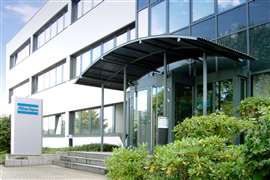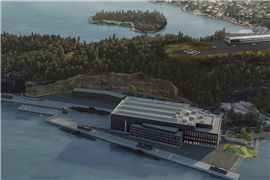Latest loaders
01 May 2008
Workhorses of the construction industry. Their versatility means they are found in a huge range of applications, from on-site muckshifting and materials handling to quarrying and stockpiling. They are of course used in many other sectors outside construction, from waste management and harsh industrial work to things like snow clearing.
According to Off-Highway Research, the Western European market for wheeled loaders is about 16700 units per year. This figure spans a massive range of machines, from compact machines designed to work on cramped urban sites, to massive machines of 30 tonnes or more for the quarrying and mining industry.
Off-highway Research breaks this down further into small wheeled loaders, defined as having 80 hp (60 kW) engines or smaller, and larger machines – 60kW or more. Sales of the more compact machines run at between 6500 and 7500 units per year, while around 10000 to 11000 of the bigger class machines are sold each year.
With construction growth in Europe fairly flat at the moment, it is not surprising that there is not much increase in demand for wheeled loaders. But the areas where there is high construction growth – the new Member States – are also finding a need for more wheeled loaders.
Dominik Ribi, marketing consultant for Caterpillar's Europe, Africa & middle East (EAME) Quarry & Aggregates Division told CE, “They still have a lot of former Soviet and Eastern European machines, which are very costly in maintenance. They will not get the productivity they need over the next five years with that equipment, so we would expect the new machine business to pick up.”
There is certainly high growth in these markets, but again, as with the picture for general construction output, it is high growth from a very low base. “The volume is still very small,” said Mr Ribi. “There will be growth, but in volume terms you still have +80% of the market in the ‘Big Five’.” The ‘Big Five’ of course being France, Germany, Italy, Spain and the UK.
For example, looking at what Caterpillar describes as medium wheeled loaders, which are its 938G to 980G models (119 to 232 kW), Mr Ribi described the situation in one of the smaller central European countries. “In Slovakia the market for medium wheeled loaders has gone from 10 to 30 units in two years, so that's +200%, but the volume is not really significant,” he said.
New Technology
Despite the somewhat lacklustre state of the market in Europe over recent years, there has been huge innovation in the wheeled loader sector. Machines today have a huge amount of electronic control systems on them, partly to aid compliance with the ever-increasing burden of noise and engine emission legislation that applies in Europe. As well as helping to achieve compliance, these electronics have delivered a lot of useful features to loader users and buyers that have enhanced productivity and efficiency.
For example, many manufacturers have developed automatic digging cycles. These ‘auto dig’ and ‘return to dig’ functions vary from brand to brand.
Some automatically position the bucket correctly at ground level at the start of the digging cycle, while others go on to lift the bucket as the loader drives into the stockpile. In both cases, all the operator has to do is push a button in the cab, and handle the driving.
Load sensing hydraulics and hydraulically driven ‘on demand’ fans are also common, and these help ensure that fuel is used as efficiently as possible by the loaders. Many new loaders also feature better cabs than before, with more space, less noise and better temperature control and ventilation than older models. Seats are also getting better, with the result that the operator is more comfortable and so gets less fatigued as the working day wears on.
An interesting new development is Caterpillar's Engine Idle Management System (EIMS), which is designed to improve fuel efficiency by automatically lowering the engine's idle speed when the machine is not working. Although this sounds like a minor point, Caterpillar believes that the way wheeled loaders tend to be used means there is significant scope for savings with this system.
Mr Ribi said, “Wheeled loaders idle a lot of the time. If you ask customers, they normally think it's around +5% to +10% of the time, but the actual figure is around +30% to +40%.” He continued, “It's often waiting around time, and some of it makes sense. If you're waiting a few minutes for trucks to arrive, it doesn't make sense to shut the machine down.”
EIMS has four modes. The ‘work and ‘hibernate’ modes lower the revs during normal operation. As the names suggests, then ‘work’ mode operates during normal operation, while ‘hibernate’ comes into play for longer periods of inactivity. It is activated when the parking brake is on and no gear is selected.
There are also the ‘battery’ and ‘warm-up’ modes, which over-ride the low revs settings when there is a need to for the machine's well-being. The ‘warm-up’ mode is self-explanatory – raises the idle point at the start of a shift to get the engine up to its ideal working temperature. The ‘battery’ mode comes into effect if the voltage on the battery drops below a given point, and speeds the engine up to charge it.
Caterpillar claims this system could save a few percentage points of fuel consumption, which is significant in the present environment when engines are already very efficient. As Mr Ribi said, “It doesn't sound much, but that's huge these days.”
New Machines
Cat's latest machine is the 930G, a 113 kW, 13 tonne loader with a 2,1 m3 standard bucket. The most noticeable thing about it is the single box-section boom, which is a feature of many of the company's loaders. This structure allows better visibility to the corners of the bucket than traditional loader lifting arms, while, according to Caterpillar, being lighter and more resistant to torsion forces.
The 930G replaces the IT28G. The ‘IT’ stood for Integrated Toolcarrier, which was Cat's way of saying it had a parallel lift loader arm and quick hitch to allow easy changes between attachments. The 930G features Cat's Versalink linkage, which has parallel lift capabilities and a quick hitch, while still maintaining good breakout forces.
The maximum dump clearance is 2,94 m, compared to 2,91 m on the IT28G, and the 930G also performs well in traditional digging applications with its 137 kN breakout force, compared to 104 kN on the old model.
One of the 930G's most interesting features however is its dual mode steering system. When in neutral or first and second gears, the operator can flick a switch in the cab to change from traditional steering to ‘QuickSteer’. This compresses the machines full lock-to-lock steering range in to just a 100° arc of the steering wheel – 50° either side of the centre point. The system is designed to reduce operator fatigue in traditional truck loading applications, where several lock-to-lock turns of the steering wheel are normally needed for each cycle.
Further up the weight category is Komatsu's WA430-6, a 19 tonne class machine. Fitted with a 165 kW engine and load-sensing hydraulics, the machine also features a new design drive train with a high capacity torque converter. This delivers high rimpull at low speed, making loading the bucket easier.
As with Komatsu's dash-5 machines, the WA430-6 features the company's SpaceCab cabin, with its spacious interior, air conditioning as standard, two-way adjustable steering column, air-cushioned and heated high comfort seat, and state-of-the-art ergonomic controls.
The noise level at the operator's ear is just 71 dBA. Operator comfort is further enhanced by the standard fitted Electronically Controlled Suspension System (ECSS). This feature increases travelling comfort and safety, whilst reducing material spillage from the loaded bucket and increasing machine lifetime due to less stress to the machine's structure.
Daewoo has made a series of updates to its midrange loaders, the Mega 250-V, Mega 300-V and Mega 400-V, which have engines rated at 121, 156 and 210 kW and weigh in at 14,2 18,1 and 22,6 tonnes respectively. All three machines now feature the latest generation of 3000 series axles from ZF, which incorporate a limited slip differential.
In the cab, standard equipment now includes a new single-lever hydraulic control that combines the lifting and digging, forward travel, reverse travel and downshift functions. The steering column can be adjusted for height and length and it has a very useful locking system. Cab air filtration has been doubled, which makes a big difference to the operator when the loader is working in a dusty environment, and last but not least, the Mega 300-V and 400-V now come with an air-suspension driver's seat.
Hitachi has a brand new range of four wheeled loaders available in Europe, which also feature ZF axles along with a ZF Ergo Power transmission. The LX 145 E-2, LX 170 E-2, LX 210 E-2 and LX 290 E-2 are all powered by Isuzu engines, rated at 108, 123, 143 and 228 kW respectively. The respective bucket capacities are 2,2, 2,5, 3,1, and 4,2 m3, and the operating weights are 12,9, 13,9, 17,5 and 21,8 tonnes.
The loaders incorporate a sophisticated shock absorption system, Ride Control System (RCS) as Hitachi calls it, which cushions the machine against shocks and bumps. The systems automatically selects the correct impact setting (the right amount of cushioning), based on travel speed. Not only does this prolong component life, but it also increases the retention of material in the bucket in carrying applications.
New Name
Last March Terex acquired the little-known German wheeled loader manufacturer Kaeble. Although the company has been around for several decades, it may well be an unfamiliar name to many of CE's readers. Sales manager Rolf Gerstmann explained, “Kaeble always concentrated on the domestic market, although at one point it had a partnership with the Libyan Government, and sold a tremendous number of machines there.”
The range comprises four machines, the SL 16, SL 18G, SL 22 and SL 28 B, with operating weights ranging from 22,6 to 29,5 tonnes. Now under Terex ownership, the plan is to move production out of the old factory in Backnang, in Southern Germany, and to increase volumes.
Mr Gerstmann said, “The plan is to move production to the former Atlas Weyhausen factory. We will start the Terex Kaeble production there at the latest in April. Our plan is to manufacture between 60 and 70 units this year. We want to get bigger numbers in the next three years. With our dealer network we would be hoping to be up around 300 or 400 units.”
This higher production volume, combined with Terex's extensive network, means the Terex Kaeble machines will be a genuine choice for wheeled loader buyers across the region. “We will be selling through our Terex sister companies, but we have dealers all over Europe, but we will also be looking at Africa and the Middle East, including CIS countries,” said Mr Gerstmann.
He believes the Terex Kaeble machines have some unique points that European buyers will find of interest. “All the Kaeble machines have a very compact design, and easy maintenance. They have a tiltable cab and tiltable rear hood, and also have low fuel consumption. They also have a high dump height, and can also supply the machines with high lifters,” he said.
At the light end of the market, Ahlmann has launched the AL 120 articulated loader, which comes with a 1,2 m3 bucket. The combination of an adjustable shock-cushioning seat, four-point cab mounting, minimum chassis borne noise levels, and smooth joystick controls make for an ergonomic machine, while under the hood a 53,5 kW Deutz turbo-diesel engine provides power to the hydrostatic power-shift transmission.
A wide range of accessories, from the crane hook, through pallet forks and mulch buckets, to snow ploughs are available in combination with the hydraulic quick coupler.
Komatsu's new compact loader is the WA80-5, which was on display at last year's Bauma exhibition, and is now commercially available. It is capable of lifting forklift payloads of 2,2 tonnes or 1,86 tonnes with a bucket. Features include an oscillating rear axle, which aids stability, while operators will appreciate the machine's large cab.
Future Developments
Later this year will see the introduction of the first loaders on the European market that comply with the Stage IIIA engine exhaust emission requirements. The laws are introduced on the basis of engine powerbands, and it is the high powered units that will be affect by the first laws at the start of 2006, so large wheeled loaders will be the first to be renewed.






